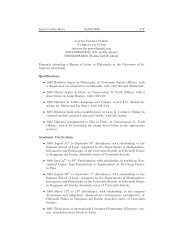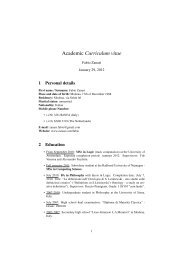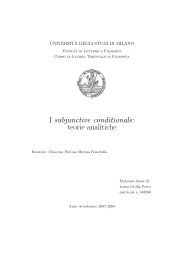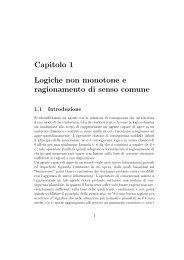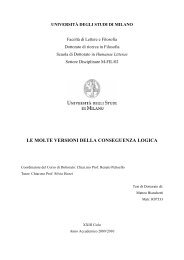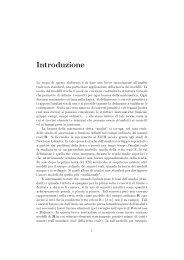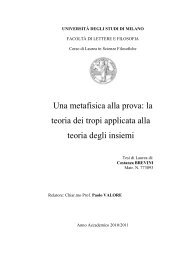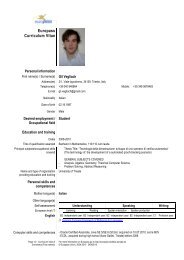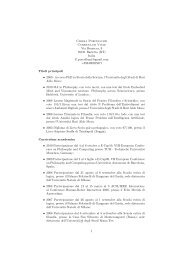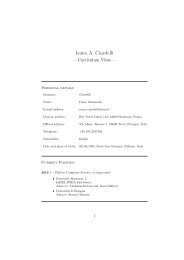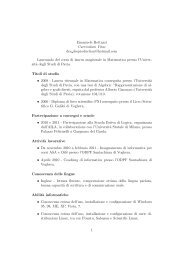Ω-Theory: Mathematics with Infinite and Infinitesimal Numbers - SELP
Ω-Theory: Mathematics with Infinite and Infinitesimal Numbers - SELP
Ω-Theory: Mathematics with Infinite and Infinitesimal Numbers - SELP
You also want an ePaper? Increase the reach of your titles
YUMPU automatically turns print PDFs into web optimized ePapers that Google loves.
CHAPTER 1. Ω-CALCULUS<br />
Example 1.12.2. We want to calculate n(N). To do so, we use that, in our model,<br />
limλ↑N |λ| = limλn,θ↑N |λn,θ|. Since<br />
<strong>and</strong><br />
we deduce that, by definition of α,<br />
λn,θ ∩ N = {1, . . . , n}<br />
n = |λn,θ ∩ N| = max(λn,θ)<br />
n(N) = lim<br />
λ↑N |λ| = lim<br />
λn,θ↑R max(λn,θ) = α (1.4)<br />
Remark 1.12.3. Equation 1.4 shows us another interesting property of the number<br />
α:<br />
α = lim<br />
λ↑R max(λ) = lim<br />
λ↑N |λ|<br />
We explicitely remark that this equality is true in the model, but is not entailed by<br />
any axiom of Ω-Calculus. In other words: this equality is generally false, unless we<br />
require that it holds by adding an appropriate axiom or by choosing a particular<br />
model of Ω-Calculus.<br />
We continue by calculating the numerosities of the sets E <strong>and</strong> O of even <strong>and</strong> odd<br />
numbers, <strong>and</strong> those of Z <strong>and</strong> Q.<br />
Example 1.12.4. We have already observed that, since N = E ∪ O, then, by finite<br />
additivity of numerosity, n(N) = n(E) + n(O). Now, we will determine n(E) <strong>and</strong><br />
n(O). As in the previous example, n(E) = limλn,θ↑E |λn,θ|. If n > 1, then<br />
|λn,θ ∩ E| = {2, . . . , n}<br />
from which we deduce |λn,θ ∩ E| = n/2 is eventually true. We conclude n(E) = α/2<br />
<strong>and</strong> n(O) = n(N) − n(E) = α/2.<br />
Example 1.12.5. We want to calculate n(Z). Since Z = N ∪ −N ∪ {0}, by using<br />
Corollary 1.6.3, we conclude n(Z) = 2n(N) + 1 = 2α + 1.<br />
Example 1.12.6. We want to calculate n(Q). As in Example 1.12.2, we have<br />
limλ↑Q |λ| = limλn,θ↑R |λn,θ ∩ Q|. We recall that, by definition,<br />
<br />
λn,θ ∩ Q = λn = −n, −n2 + 1<br />
, . . . , −<br />
n<br />
1 1<br />
, 0,<br />
n n , . . . , n2 <br />
− 1<br />
, n<br />
n<br />
so |λn| = 2n 2 + 1. Taking the Ω-limit, we obtain n(Q) = 2α 2 + 1.<br />
In our model, we can also answer the open question of Example 1.8.8. In particular,<br />
we will show that min((0, 1) ◦ ) < 1/α.<br />
Proposition 1.12.7. min((0, 1) ◦ ) < 1/α<br />
40




